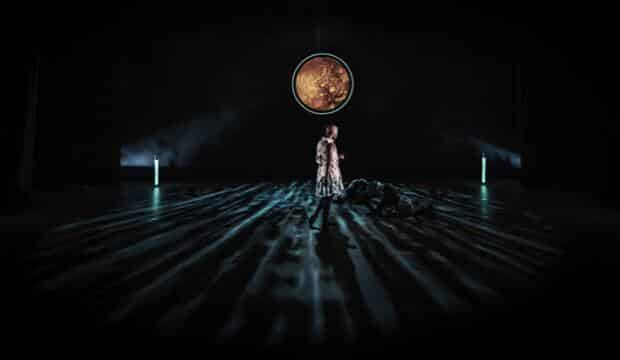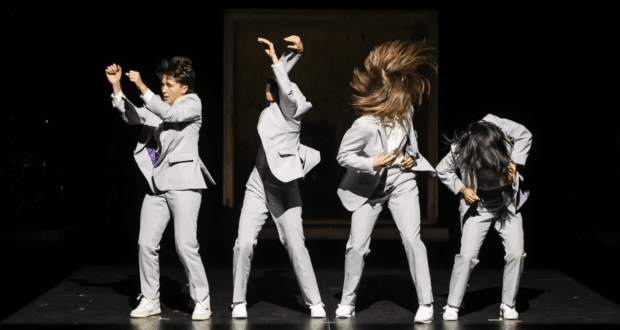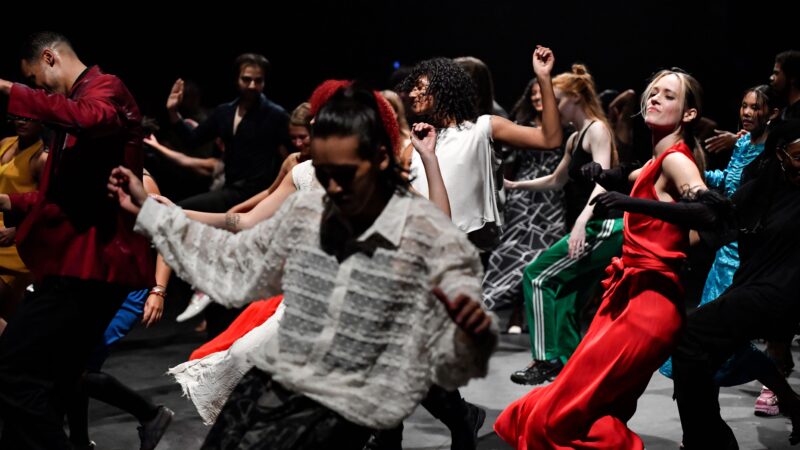Sadler’s Wells
Since its inception in 2015 Kyle Abraham’s theatre company, A.I.M. by Kyle Abraham (standing for Abraham in Motion) has been on an impressive trajectory. A “post-Modern Gumbo” as Abraham puts it, of ideas, Black culture, history, and movement. From their home in New York the company’s far-reaching limbs touchdown in little old London.
Requiem: Fire in the Air of the Earth is a visually stimulating recontextualisation of Wolfgang Amadeus Mozart’s Requiem in D Minor. The celebrated electronic musician Jlin takes the lead in spinning the classic tune into something fresher. A thumping remix, with heavy repetition and sampling of the choral sections. The electronic opus is much more interesting to dance to if a little relentless to listen to.
Giles Deacon has clad the 10 dancers in spliced 18th-century gear. Disconnected ruffles sit on elbows, tutus spring from pointy hips. Silky skirts and swishing layers of white gossamer constantly create changing shapes to keep your eyes entertained. The silk is printed with scribbled shapes and writing, and the dancers don red masks plastered onto their faces. Looking very much like a Venetian carnival troop they cavort over one another with endless athleticism.
Behind the bare stage hangs Dan Scully’s glowing eye/pool. The ring of LEDs is a flexible surface for which to project shifting oil lamp-like colours. Scully’s set is simple but effective with hanging strip lights that change colour and therefore mood. There is also a slightly pointless but aesthetically interesting latticework pipe pattern over part of the back wall.
Kyle Abraham’s choreography is impressive and far-reaching. He juxtaposes classical balletic form with stunted shaking and obsessive convulsions. The blend of ballroom movements, sassy hip spins, and aggressive almost krumping proves his confidence in incorporating different dance histories. This is especially important to highlight the black communities’ creation of many of these fabulous new forms. If the Gumbo mentioned above is an intoxicating mix of styles, feelings, and exploration then serve me two helpings. Even without much narrative the beauty and power of the movement score is felt keenly.
However, some things hamper the evening, some rogue shrimps in the simmering seafood pot. The first is a practical issue. There seem to be large gaps between musical sequences, which leave the dancers rather stranded waiting for their cues.
More of a complex issue comes with the insistence to use Mozart in the first place. Jlin is a talented producer and able to craft amazing stand-alone music. The reason for reworking this classic is never made clear. The lack of justification on how this fits with the themes mentioned in the blurb (afterlife, reincarnation, mythology, and folklore) makes the whole show feel like it’s built on a foundation of sand.
The march of A.I.M. continues, and I look forward to their next visit, exhibiting their distinctive style and voice. With more focused attention to theme and a little tightening of the nuts and bolts, I’m sure the talent within this company will bubble up unobstructed.
for more challenging dance click here!



